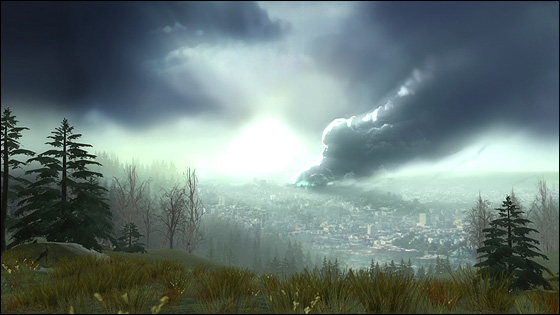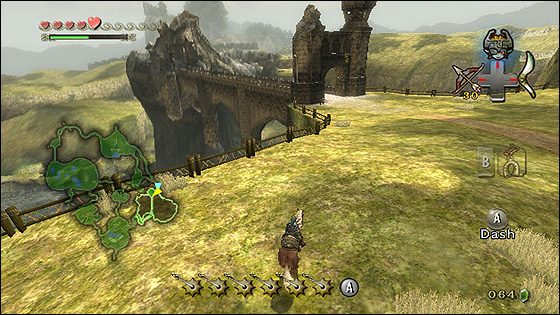Half-life: Episode Two Commentaries
July 11th, 2009

If you’ve followed my other articles about the Half-life series up till now then my reaction to Half-life: Episode 2 might not be such a huge surprise. To quickly retrospect; Half-life is the aged original, primitive and wonky by today’s standards, but no less a cornerstone for the industry. The implicit storytelling, large, interconnected world and seamless narrative were revolutions in design at the time, establishing the franchise’s high pedigree, yet beneath all the narrative kicks, Half-life was a relatively vanilla first person shooter. Half-life 2 is the critically acclaimed band-aid solution; an amalgamation of the same uninteresting first person gameplay mixed with nifty, albeit inconsistent and tacky, distractions. These distractions segment the various chapters of the game (ie. gravity gun for this area, antlion bait for another) making the title feel like a circus of discrepant ideas glued together, still not enough overcome the lethargic gameplay, as made embarrassingly apparent by the early sections of the game. Episode One tore away from the Half-life 2‘s fragmented approach to gameplay, focusing on diversifying set pieces and minor confrontations. Partner Alyx played her part as an individual catalyst for rejigging the former framework. She worked (and still works) better as a narrative piece than an instrument for the gameplay. While breaking away from Half-life 2‘s cheap thrills, Episode One was an unrealized remix of Half-life 2, which is where Episode Two enters.
Episode Two is not a complete realization of Episode One‘s breakaway, it’s maybe 75% of the way towards thrilling but never quite hits the spot. Still, in comparison to Half-life 2, Episode Two represents a marked improvement, a highlight in the series. Think of it as Episode Two as a streamlined version of Half-life 2, set in a completely original environment.

The last point is something that will immediately standout to continuing players. Instead of trawling the European-esque cityscapes of City17, Gordon is now out in the wilderness. This new environment is lovingly crafted with a fine layer of grandiosity characterizing the environment in Valve’s signature style. The new visual aesthetic is teamed with some impressive improvements in graphical fidelity to the Source engine, making for another visually striking entry in the series. The new style is well suited to the episodic format as it’d likely lose flavour if it were drawn out any longer. It’s aided by locales that splinter away from the Alaskan-themed forestry. Gordon is rather preemptively thrown into a series of underground catacombs, shifting gears almost from the journey’s get-go. Once he is reacquainted with the over world, the rest of the game plays out above ground, save for the interior areas of White Forrest and a scattering of small towns, outposts and camps along the way. Each of these pit stops, these changes in location, have two functions. The first is to allow the game to visually chew its food and never become to entrenched in the one aesthetic or colour scheme. Gameplay-wise the environments stake off familiarity and grind, provide their own inherent challenges for play. The caves are claustrophobic playing areas, inhabited by menacing Ant Lion Guards yet balanced by the abundance of sticky glowworms which heal Gordon’s health and light up the glossy interiors. The wilderness areas are large and expansive, allowing for Hunters to give chase or offering enough room for Gordon to drive a car around. Set piece events, such as the final defense of the White Forrest station are suited and designed around their locales. As such the environments appropriate the confrontations, ie. the crux of the game. Already we can observe how the design has been re-centred on the environment and not whatever gimmick at hand.
You see, the gimmicks employed in Half-life 2 now conglomerate to form the start-game toolset for the episodes. Some of them are sacrificed (antlion bait), some reapplied (squad-based gameplay) and others made default (gravity gun) – Valve have streamlined the experience which inevitably forces them to redesign the crux of the the episode’s design; the moment-to-moment gameplay. Meaning that since they now have a decent base to work with and Valve can finally begin to design a decent first person shooter, which Episode Two is the first of.
Additional Readings
Half-life 2: Episode One The Story so Far
The Final Word on Twilight Princess
July 8th, 2009

In my lengthy editorial on Zelda: Twilight Princess‘ balance between conformity and innovation, I stressed that the game’s overall merit can be judged on the enjoyment of the inspired, new content weighed against the grind of iterated material. I probably exhausted the idea a little too extensively, all the while never sharing my own commentaries on how the game stacks up.
I’m actually a little hesitant to discuss my enjoyment of Twilight Princess, since I’m fearful that this old-stuff-new-stuff idea was just some wayward thought that got caught in my head and eventually evolved into a stigma which has poisoned my enjoyment. My thoughts have been stewing on Twilight Princess for two years now so it’s likely that my distaste for the realistic graphical style – over the cel-shaded look – has spiked the melting pot. Honestly though, I can’t let this go! Despite the occasional bright idea, Twilight Princess is monotony compared to the youthful Wind Waker. Even the abstract elements – while in some cases astoundingly brilliant – pale to the vigor of macabre which made Majora’s Mask all the more riveting. It seems like an amalgamation of Ocarina of Time (general design), Majora’s Mask (Twilight world) and some tidbits from Wind Waker (eyes, characterization) with no distinct personality of its own – let’s assign it generic Lord of the Rings fantasy, eh? It depends on how mean you’re feeling.

I’m mostly pleased with Twilight Princess and there’s no reason why I shouldn’t be – it’s objectively the most refined and endearing Zelda experience ever to come out of Nintendo. Leagues better than Wind Waker‘s slim content. Sure I loved the – awfully titled – toon Link, Ayril and their melon-headed Grandma; those characters wear the largest hearts, but admittedly the game was a slouch when it came to content, unfortunately.
Sure the content was thinly spread, but the relatively little offered in Wind Waker felt completely fresh. Wind Waker introduced an entirely original world filled with water, with accommodating sailing mechanics and original characters, including a new race to the series (the Rito people) as well as the re-jigged Deku tribe. A handful of new items were included such as the Deluxe Picto Box and Deku Leaf. Link’s eyes played a significant part in the game, the combat was layered with some context sensitivity and unique enemy types. Most significant was the change in scenery, similar to Link’s Awakening, Wind Waker has a seaside theme. This was further expanded with locales sporting a real showmanship such as the Forsaken Fortress and Dragon Roost Cavern, the latter, a dungeon which weaves in and out of a giant volcano.
In contrast, Twilight Princess is more or less Ocarina of Time redux with some tweaks. The new features include the Wolf mechanics, Midna, upgrades to horseback riding, combat and some items. The locales are mostly the same and/or similar to those seen in Ocarina of Time or other Zelda titles for that matter, the Palace of Twilight proving to be a surreal exception. Sure, the differences on paper don’t match my claims terribly well, but the overall layer of difference, instilled by Wind Waker‘s graphic design, coupled with copious amounts of sea voyaging makes it the most individual of the pair. Conversely, the samey-ness of Twilight Princess works in the opposite manner, layering the game in a sense of familiarity, you know, OOT just in higher res.

What this all amounts to is the obvious sense of personal conflict reflected by my writing. Wind Waker takes you by the heart strings and never ceases, until Link drives his miniature blade into the centre of Gannondorf’s forehead. Twilight Princess on the other hand is the better game and by a wide margin. Which one do I favourite? Wind Waker, of course; a preference which itself loomed over my 62hr play time in Twilight Princess. It feels like a missed opportunity which has likely been tossed aside for good except for the low-res DS titles which I wish I could make some sort of jarred, baseless assertion about.
Alas, amidst my confusion I haven’t actually evaluated Twilight Princess yet, have I? Does the new stuff outweigh the old? Well…not enough to overcome my bias that the decision to adopt realistic visuals resulted in the lack of structural innovation to the title. Yes, they’re unrelated (or at least should be treated as such), but the new material and tweaks in Twilight Princess fails to persuade me otherwise. This underlying niggle put a downer on my experience, but didn’t destroy or even pose a huge detriment to the overall game, given that I had to first place myself in the right mindset. I can play Twilight Princess and enjoy it as ‘The state of Ocarina of Time in 2006’ without my detestation getting in the way, which I guess makes Twilight Princess a pretty good game then.
Additional Readings
Behind the Legend [Zelda: Wind Waker]
Zelda: Twilight Princess – Nintendo-fying Stolen Mechanics
July 7th, 2009
Carrying on from my previous comments on the weight of creativity in Zelda: Twilight Princess, another way that Nintendo can continue to foster creativity with the next potential Zelda is to Nintendo-fy the innovations of others – not just steal, but reinvent and adapt. Let’s say that the next Zelda is a sequel to Twilight Princess and adopts a mostly similar framework, innovating through content instead of changing the foundations of the series – which seems to be the case. For this sequel to not be derivative of the previous game (which was itself mostly derivative of prior games) Nintendo would need to inject a stream of constantly innovative ideas. Even for the mighty Nintendo, being wholly innovative in such a way is no easy task, so why not adopt the ideas and mechanics of other games and re-jig it for your own?
Nintendo successfully did so with stealth sections in Zelda: Wind Waker. The whole adaption was one big spoof of Metal Gear and for players in on the joke it was a great joy to see the two styles collide. Besides the referential humour, the actual play mechanics felt similar yet given a whole new interpretation – one of the many fruits of the game.
Such a technique is used (and often buggered up) by western developers all the time, I think that Nintendo could craft a lot of success but exercising this technique a little more in their next title (if it were to be more-of-the same vein to TP). The trick is to understand the way the borrowed mechanics are ‘fun’ and then draw on that in a manner that is relevant to your own game. Liberally copy and pasting almost always results in a big failure because of the different contexts. Most western developers fail at understanding how the mechanic creates ‘fun’ and hence fail to reapply it properly to their own game, hence we call it stealing rather than a softener word like borrowing. Nintendo usually have have a firm grasp on their properties and what makes them enjoyable so that ought to capitalize on this technique some and see how it works for them.



 Game Design Companion: A Critical Analysis of Wario Land 4 - $7.99
Game Design Companion: A Critical Analysis of Wario Land 4 - $7.99 Level Design: Processes and Experiences
Level Design: Processes and Experiences Speed Boost: The Hidden Secrets Behind Arcade Racing Design - $5.99
Speed Boost: The Hidden Secrets Behind Arcade Racing Design - $5.99 Adventures in Games Analysis: Volume I - $5.99
Adventures in Games Analysis: Volume I - $5.99







